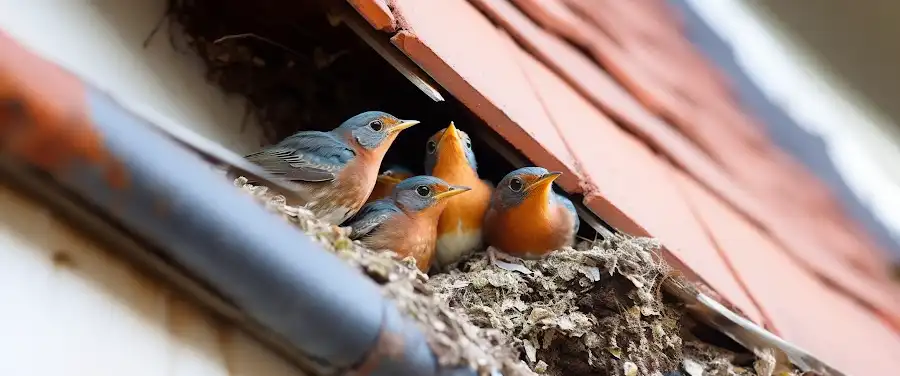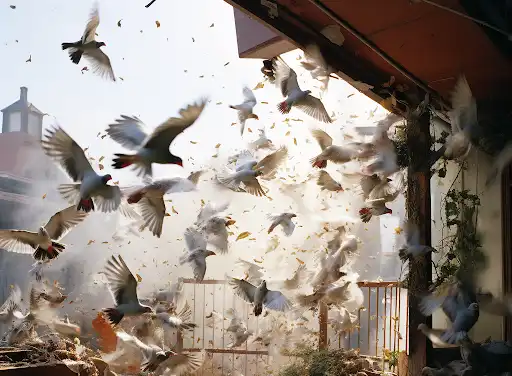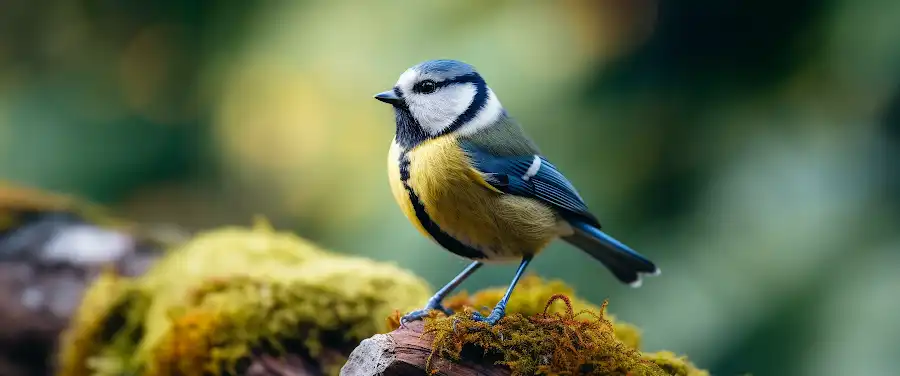
Home sweet home – except when you’re sharing it with unwanted tenants: a bevy of birds making their nests in your property. Bird infestations can create quite an unpleasant stirring, both literally and figuratively. They may seem harmless at first – a fleeting shadow or a distant chirp – but before you know it, they have nested and made themselves quite at home. It’s important to emphasize the need for early detection in mitigating negative effects, but how can you spot them?
Experiencing bird infestation signs can be a lot like trying to solve a winged whodunit. The early signs are always subtle, a mysterious tune carried on the wind, or a single feather lying forlorn in your backyard. But if not checked and managed swiftly, these avian agents can turn from mere nuisance to major havoc, damaging your property and potentially causing health issues. You need both an open eye and a keen ear to unravel these signs; otherwise, the consequences could be quite costly.
Understanding the signs of a bird infestation in the early stages can help mitigate potential damage and maintain the sanity of your home. Whether it’s the incessant pecking sounds that disrupt your peaceful afternoons or droppings decorating your lovely balcony, the universe is trying to send you a message. Listen. It’s time to call in the pest control professionals. And now that we’ve perched ourselves on this topic, let’s fly further to explore what causes these bird invasions.
What are the Implications of a Bird Infestation?

Bird infestations can lead to serious issues for both your health and your property. The moment you notice any signs of a bird infestation, it is crucial to take immediate action to prevent further hassle and damage.
Health Hazards Associated with Bird Droppings
Bird droppings are not just unsightly, but also a breeding ground for a number of diseases and parasites, including histoplasmosis, cryptococcosis, and psittacosis. According to the Centers for Disease Control and Prevention (CDC), inhaling the spores from bird droppings could potentially cause severe respiratory issues and other health problems. Therefore, cleaning and disinfecting the areas affected by bird droppings is essential to avoid these health hazards.
Property Damages Due to Nesting and Roosting
Aside from health risks, bird nesting and roosting can lead to substantial property damage. Birds often build their nests in roof eaves, gutters, and other architectural features of buildings, leading to blockages and structural damage over time. They’re also known to peck at insulation, siding, and windows, causing further property harm.
Noise and Other Potential Disturbances
Another sign of a bird infestation is the disruptive noise created by a large flock of birds. This noise pollution can be especially problematic if the birds are roosting near residential areas, disturbing peace and sleep.
According to the Environmental Protection Agency (EPA), long-term exposure to noise above 60 decibels can cause stress, sleep disorders, and cognitive impairment.
To better understand the impact of a bird infestation, let’s look at the table below:
| Implication | Details |
|---|---|
| Health Hazards | Bird droppings can cause several diseases like histoplasmosis, cryptococcosis, and psittacosis. |
| Property Damage | Birds can cause significant damage to buildings by building nests in eaves and gutters. Also, they can peck at insulation, siding, and windows. |
| Noise Pollution | The noise created by a large flock of birds can cause stress, sleep disorders, and cognitive impairment. |
As you can see, the implications of a bird infestation extend beyond simple inconvenience or aesthetic concerns. By recognizing the signs of a bird infestation, you can take necessary steps to mitigate these risks.
Next, let’s delve into the most common types of birds that often contribute to infestations. This understanding will help you identify the signs of a bird infestation promptly and handle it effectively.
What are the Most Common Types of Birds in Infestations?

When we think of bird infestations, our minds automatically envision a scene from Hitchcock’s “The Birds.” But the reality is less dramatic, and it often involves common birds like pigeons, sparrows, and starlings. These avian creatures, while generally harmless in the wild, can become a significant nuisance when they flock to our homes or businesses in large numbers.
Pigeons, for instance, are one of the most common culprits. They’re everywhere, from bustling cityscapes to quiet suburban retreats. These birds are notoriously hardy and prolific breeders, meaning that a small group can rapidly turn into a full-blown infestation.
Sparrows might seem too small to cause much concern, but appearances can be deceiving. These tiny birds, like pigeons, are not picky about their habitat and can easily set up shop in your property. Their nests can block ventilation systems and their droppings can cause health issues, making them unwanted tenants.
Lastly, let’s consider starlings. These birds are known for their stunning flocks or “murmurations.” Beautiful in the wild, but a nightmare when they descend on your property. They reproduce quickly, and with their voracious appetites, can decimate local plant life and compete with native bird species for resources.
Understanding the common types of birds that might take up residence in your property is the first step in effective pest control. Remember, dealing with a bird infestation is all about knowing what you’re up against. Once you can identify which species is causing the problem, you’re better equipped to implement a successful strategy for removal.
Moreover, if you think bird infestation is a minor issue, think again. According to the Centers for Disease Control and Prevention, bird droppings can lead to several diseases, including Histoplasmosis, Candidiasis, and Cryptococcosis.
Knowing the common pest birds, pigeons, sparrows, and starlings, and their behavioral patterns can help you devise a better action plan to combat them. After all, prevention is always better than cure.
Imagine finding your stylish clothing, treasured books, and other household items shredded to bits. Rodents are not picky about what they gnaw on, resulting in personal property damage. Further, they often venture into food supplies, contaminating them and leading to further losses. Destruction and contamination by rodents turn your beloved household items into chew toys and cause the loss of useable supplies, exacerbating the economic impact of an infestation.
Top 10 Signs of a Bird Infestation

Having birds in and around your home can be a delightful sight, their chirping and colorful plumage often adding to the charm of your surroundings. However, when they start to appear in massive numbers, it can indicate a possible infestation. Recognizing the signs of a bird infestation early on can help you address this issue before it escalates. Here’s a detailed look at the top 10 signs to watch out for.
1. Frequent and/or large number of bird sightings
One of the most apparent signs of a bird infestation is the constant presence or sudden increase in the number of birds in your property. If more birds than usual are flocking to your home, it could indicate an infestation.
2. Regular noise from birds in the building
You’re likely dealing with an infestation if you consistently hear bird noises inside your house. These sounds can include chirping, fluttering, or scratching noises.
3. Accumulation of bird droppings
From the gutters to your window sills, excess bird droppings are a surefire sign of a bird infestation. Aside from being unsightly, bird droppings can also cause health problems and property damage.
4. Visible nests on property
Birds tend to settle in areas where they have easy access to food and shelter, making your home’s eaves, rooftops, or trees perfect nesting spots. The presence of multiple nests indicates a high possibility of an infestation.
5. Presence of dead birds
The presence of dead birds can mark an infestation in progress. They could have died due to diseases, fights for territory, or other hazards present in the infested area.
6. Unexplained damage to property
An unanticipated increase in property damage could be the work of birds. They can harm the structure of your building, your garden, and even your outdoor furniture.
7. Bird mites
Small but bothersome, bird mites are parasites that feed on birds and can infest your home. If you’re bitten by them or notice their presence, it’s a strong indicator of a bird infestation.
8. Overabundance of bird feathers
A sudden increase in bird feathers inside or around your home implies that birds are spending a significant amount of time there, signaling a likely infestation.
9. Frequent chirping sounds
Though chirping can be pleasant, incessant chirping, especially during the night, can suggest a bird infestation. It’s likely a sign that birds are nesting in or near your home.
10. Bird tracks and signs on property
Lastly, if you see bird tracks or signs more frequently, birds might have made your property their new home. Look for tracks around your property, particularly around bird feeders, trees or water sources.
In conclusion, bird infestations might seem harmless at first, but they can pose significant challenges if not properly managed. However, by knowing and recognizing the signs listed above, you can take timely action.
How to Prevent a Bird Infestation?
Preventing a bird infestation is often more feasible and cost-effective than dealing with one. If you’re concerned about birds turning your property into their new home, don’t worry. Here, we propose practical solutions to help you ward off these feathery intruders before they become a problem. By focusing on bird infestation prevention, you can enjoy a bird-free home.
The first preventive measure involves the simple act of property cleanliness. Keep your surroundings clean, whether it’s your garden, lawn, or balcony. Bird get attracted to areas with food, water, and elements that resemble their natural habitat. Hence, avoid leaving any pet food outside, secure garbage cans, remove spillages promptly, and ensure standing water is drained.
Consider sealing entry points to your house, such as open windows, gaps under the door, or cracks in the walls. These unassuming spots often serve as gateways to your home for many birds seeking refuge or a nesting spot.
Next, explore bird deterrents options that can help keep birds away from your property. These devices come in various forms such as spikes, nets, reflective objects, and special gels that make surfaces uncomfortable for birds to land on or nest.
For an expert opinion, you might want to visit the National Pest Management Association for more comprehensive solutions.
Below is a table illustrating some commonly used bird deterrents, their applications, and level of effectiveness.
| Type of Deterrent | Application | Effectiveness |
|---|---|---|
| Spikes | Roofs, balconies, ledges | High |
| Nets | Trees, gardens, openings | Medium |
| Reflective Objects | Gardens, patios, balconies | Low to Medium |
| Bird gels | Ledges, balconies, window sills | High |
It’s important to remember that different species of birds react differently to various deterrents, and what works for one species might not work for another. Hence, it’s always best to do some research or consult with a professional before deciding on a bird deterrent strategy.
These bird infestation prevention strategies are only a starting point, but they’re vital first steps in warding off a potential infestation. With diligence and regular maintenance, you should be able to create an environment that is inhospitable to birds, keeping them from nesting and causing trouble on your property.
Conclusion
As a homeowner, recognizing the signs of a bird infestation can save you a lot of trouble down the road. Birds, as picturesque as they may seem in the open skies, can wreak havoc when they decide to nest in your home. Whether it’s the incessant chirping or the deposits of droppings, persistent bird infestations can disrupt your peaceful sanctuary.
Here, we’ve boiled down the top 10 signs of bird infestations that might require immediate attention.
- Noise: If you hear unusual sounds like tweeting, flapping or cooing particularly during early mornings or late evenings from your attic or roof, there might be a bird problem.
- Nesting Materials: Finding feathers, twigs, grass, and other debris in unexpected places not only looks messy, it could be a warning sign of nesting birds.
- Bird Droppings: Notice fresh bird poops frequently all around your property? This can be a major sign of a bird infestation, along with posing a health risk due to the diseases they can carry.
- Bird Mites: Bird mites are tiny parasitic insects feed on birds. If you have persistent itching, bird mites could be a sign of a bird infestation.
- Damages: Physical damage like pecking holes, scratches and ripped insulation can be the handiwork of birds nesting in your property.
- Numbers: If there is an unusual number of birds near your property on trees or rooftops, be cautious.
- Nests: If you spot nests on your property, there’s no doubt that there’s a bird problem.
- Bird Sightings Inside House: Birds flying around the house, is a dead giveaway that there is a bird infestation.
- Dead Birds: Unfortunately, dead bird sightings can also be a part of bird infestation signs.
- Bad Smell: Lastly, an unpleasant smell can point to a bird problem, as the scent could be from bird feces or dead birds.
Being vigilant and recognizing these signs early can make a huge difference. Just like any other pest, prompt action is the key to control a bird infestation. If you suspect that you might be dealing with a bird infestation, seek timely help from a trusted professional pest control service, ensuring effective bird infestation management and the peaceful living environment your home should be.
Bird Infestation Indicators
| Sign | Description |
|---|---|
| Noise | Unusual sounds from your attic or roof |
| Nesting Materials | Feathers, twigs, grass, etc. scattered around |
| Bird droppings | Frequent sighting of bird poops |
| Bird Mites | Persistent itching due to tiny parasites |
| Damages | Scratches and ripped insulation |
| Numbers | Unusual number of birds near your property |
| Nests | Nests found on your property |
| Inside sightings | Birds flying in your house |
| Dead Birds | Dead birds in unusual places |
| Bad Smell | Unpleasant smell due to bird droppings or dead birds |
In conclusion, recognizing signs of bird infestations and taking timely action for the prevention and control of bird infestations will not only ensure your home’s tranquillity but also its cleanliness and hygiene. Be informed, be vigilant, and let’s keep our homes bird-infestation-free!
Frequently Asked Questions about Signs of a Bird Infestation
Table of Contents
- What are the Implications of a Bird Infestation?
- What are the Most Common Types of Birds in Infestations?
- Top 10 Signs of a Bird Infestation
- 1. Frequent and/or large number of bird sightings
- 2. Regular noise from birds in the building
- 3. Accumulation of bird droppings
- 4. Visible nests on property
- 5. Presence of dead birds
- 6. Unexplained damage to property
- 7. Bird mites
- 8. Overabundance of bird feathers
- 9. Frequent chirping sounds
- 10. Bird tracks and signs on property
- How to Prevent a Bird Infestation?
- Conclusion
- Frequently Asked Questions about Signs of a Bird Infestation




